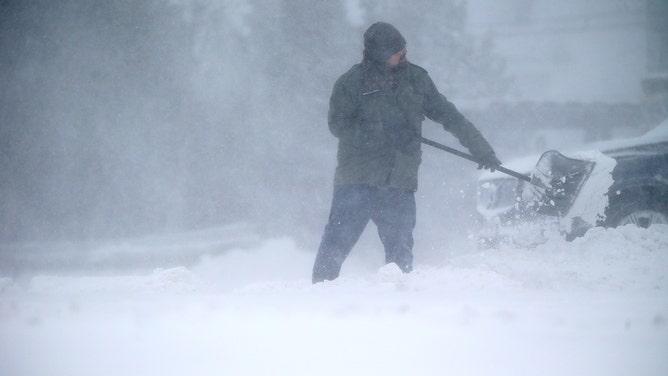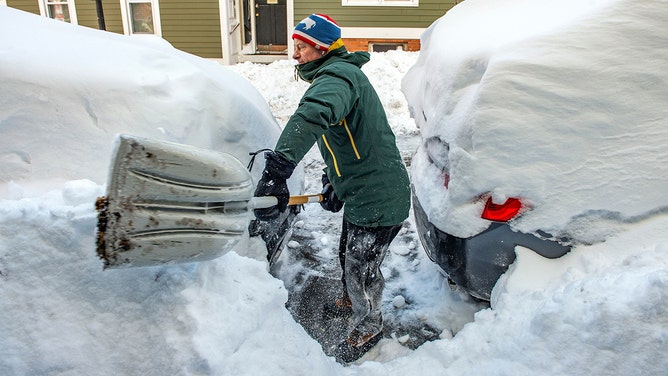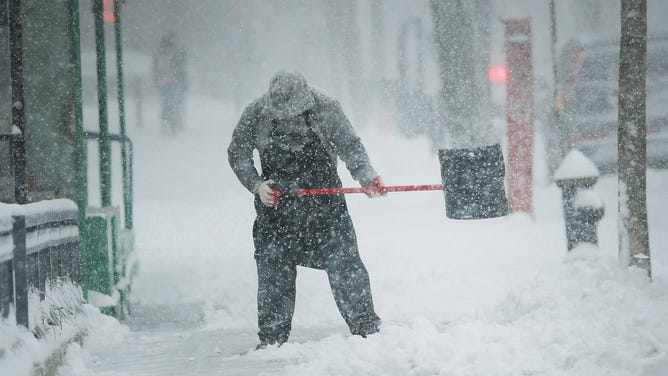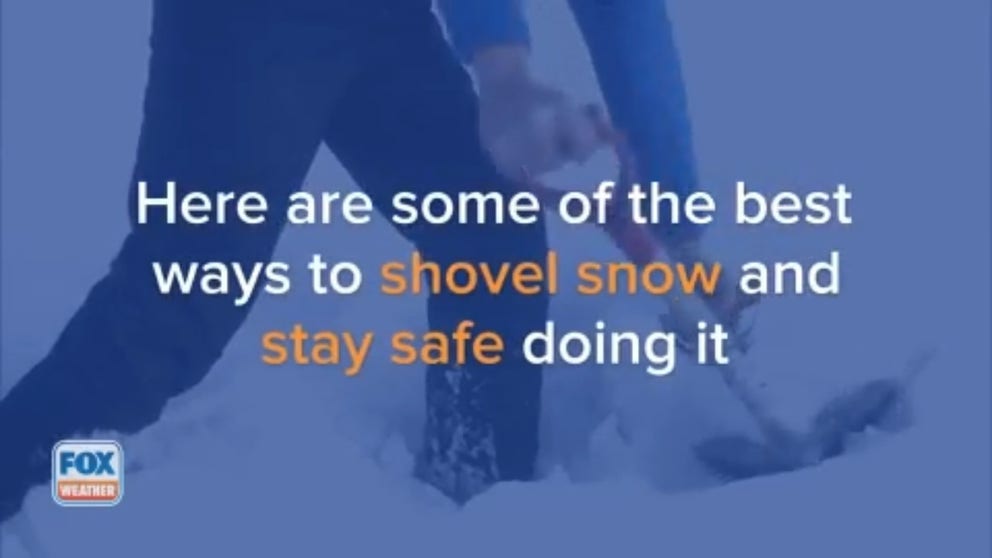Snow shoveling safety: The easiest and safest way to clear that driveway after a big snowstorm
Have a plan ready before you begin to shovel. It will make the chore of removing snow less stressful if you know ahead of time how to tackle to process.
Here are some of the best ways to shovel snow
Most people don't look forward to shoveling snow, but it can be a lot easier and safer if you know how to do it.
Most people don't look forward to shoveling snow after a winter storm, but the painful task of shoveling your driveway, sidewalks and stairs can be easier if you know how to do it properly.
First and foremost: Have a plan. It will make snow shoveling less stressful if you know how to tackle the process ahead of time.
The easiest way to shovel snow

FILE - High winds and blowing snow did not stop some from shoveling out in Hull, Massasschuttes, on Jan. 29, 2022, in near whiteout conditions.
(Jonathan Wiggs / Getty Images)
If it has stopped snowing, Home Depot recommends working in sections to clear away all the snow on your driveway and sidewalks. But if it's still snowing, you may want to make a first pass to make the rest of the removal process more manageable once the snow has stopped falling.
Keeping up with snow shoveling while it's still snowy is a good safety tip. It could help prevent injuries while shoveling snow at your home, and your shoulders and back will thank you.
Once you've made your plan and you're ready to begin, you'll want to clear a path to your car if you park in a driveway. Home Depot says that's because you can start your car and turn on the defrosters, so once the driveway is clear, you can easily remove the snow and ice from your vehicle.
HOW TO SUCCESSFULLY DIG YOUR CAR OUT FROM THE SNOW, AFTER YOU FIND IT
Next, Mass.gov says the best way to begin to shovel out your driveway is to start at the opening and shovel snow in the direction of traffic. To do that, face the road from the driveway and shovel the snow to the right.
But shovelers beware: You'll want to do this after a snowplow comes by. It will be incredibly frustrating to do all of that work only to have a plow push all the snow back to the start of the driveway.
It's also an important to clear a path around any fire hydrants and storm drains along the curb around your home.
REMOVING ICE FROM YOUR WINDSHIELD CAN BE EASY – IF YOU DO IT THE RIGHT WAY
Home Depot recommends tossing piles of snow entirely out of your driveway. You won't want to start shoveling and tossing those scoops of snow over sections you haven't gotten to yet. Work smarter, not harder. Just be careful not to throw snow on top of shrubs or other plants, as that could crush them.
It's important to ensure that there aren't any large piles of snow or snowdrifts covering the vent to your dryer on the side of your home, as that buildup of snow and ice could trap dust and other debris, posing a fire hazard.
How to properly shovel snow to prevent injuries

FILE - A resident shovels snow around vehicles in Boston, Massachusetts, on January 30, 2022.
(Joseph Prezioso/AFP / Getty Images)
Ok. You made a plan, and you're ready to get to work. Now what?
Your health should be your No. 1 priority when you're shoveling snow, so you'll want to stick with a proper technique to make the process as easy as possible while staying safe.
MEDICAL EXPERTS WARN SHOVELING SNOW CAN BE DANGEROUS TO YOUR HEALTH
If you weren't already aware, if it's snowy, then it will likely be cold. And the wind will make it feel even colder. But Home Depot says the wind doesn't need to be your enemy while shoveling snow. Use it to your advantage by shoveling in the direction the wind blows, if possible.
When you start shoveling, grip near the shovel blade to keep it close to you when lifting the snow. That will reduce the strain on your back. And always remember to bend your knees and lift with your legs.
And don't worry about piling as much snow as possible onto your shovel to save time. If you shovel smaller amounts that take twice as much time, your body will thank you.
Also, it's easier to push the snow with your shovel than lift it.
SORE FROM SHOVELING SNOW? HERE'S WHAT YOU SHOULD DO
Take a break, or two or three…

FILE - Shoveling snow is hard work especially if your body is not in shape.
(Photo by Spencer Platt/Getty Images / Getty Images)
According to the American Journal of Emergency Medicine, more than 11,000 people seek medical attention for injuries associated with snow removal every year.
While most people suffer from back injuries or hyperthermia, cardiac-related hospital visits were the most concerning and accounted for all deadly accidents, researchers found.
Like you would before a run, workout, or other physical activity, warm up your muscles before getting to work.
YOU PROBABLY HAVE THESE WINTER STORM HACKS IN YOUR PANTRY
Dress in layers and remove them as you start to warm up to help maintain a comfortable body temperature, according to Travelers.
Don't overexert yourself, and take plenty of breaks. Travelers says you should consider taking a break after 20 to 30 minutes, especially when it's heavy, wet snow.
And be sure to drink plenty of water and stay hydrated while you're shoveling snow.
